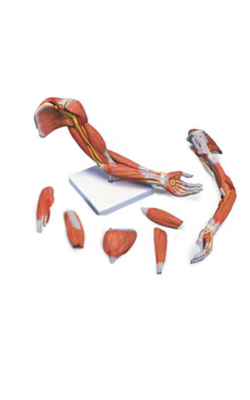Main Model

3 Radial nerve

Radial Nerve in Arm
The radial nerve in the arm supplies all the muscles in the posterior compartment of the arm (and forearm). The radial nerve enters the arm posterior to the brachial artery, medial to the humerus, and anterior to the long head of the triceps, where it gives branches to the long and medial heads of the triceps. The radial nerve then descends inferolaterally with the profunda brachii artery and passes around the humeral shaft in the radial groove. The branch of the radial nerve to the lateral head of the triceps arises within the radial groove. When it reaches the lateral border of the humerus, the radial nerve pierces the lateral intermuscular septum, and continues inferiorly in the anterior compartment of the arm between the brachialis and the brachioradialis to the level of the lateral epicondyle of the humerus.
Anterior to the lateral epicondyle, the radial nerve divides into deep and superficial branches.
• The deep branch of the radial nerve is entirely muscular and articular in its distribution.
• The superficial branch of the radial nerve is entirely cutaneous in its distribution, supplying sensation to the dorsum of the hand and fingers.
Radial Nerve in Forearm
Unlike the medial and ulnar nerves, the radial nerve serves motor and sensory functions in both the arm and the forearm (but only sensory functions in the hand). However, its sensory and motor fibers are distributed in the forearm by two separate branches, the superficial (sensory or cutaneous) and deep radial/posterior interosseous nerve (motor). It divides into these terminal branches as it appears in the cubital fossa, anterior to the lateral epicondyle of the humerus, between the brachialis and the brachioradialis. The two branches immediately part company, the deep branch winding laterally around the radius, piercing the supinator en route to the posterior compartment.
The posterior cutaneous nerve of the forearm arises from the radial nerve in the posterior compartment of the arm, as it runs along the radial groove of the humerus. Thus it reaches the forearm independent of the radial nerve, descending in the subcutaneous tissue of the posterior aspect of the forearm to the wrist, supplying the skin.
The superficial branch of the radial nerve is also a cutaneous nerve, but it gives rise to articular branches as well. It is distributed to skin on the dorsum of the hand and to a number of joints in the hand, branching soon after it emerges from the overlying brachioradialis and crosses the roof of the anatomical snuff box.
The deep branch of the radial nerve, after it pierces the supinator, runs in the fascial plane between superficial and deep extensor muscles in close proximity to the posterior interosseous artery; it is usually referred to as the posterior interosseous nerve. It supplies motor innervation to all the muscles with fleshy bellies located entirely in the posterior compartment of the forearm (distal to the lateral epicondyle of the humerus).
Radial Nerve in Hand
The radial nerve supplies no hand muscles. The superficial branch of the radial nerve is entirely sensory. It pierces the deep fascia near the dorsum of the wrist to supply the skin and fascia over the lateral two thirds of the dorsum of the hand, the dorsum of the thumb, and proximal parts of the lateral one and a half digits.